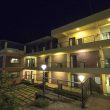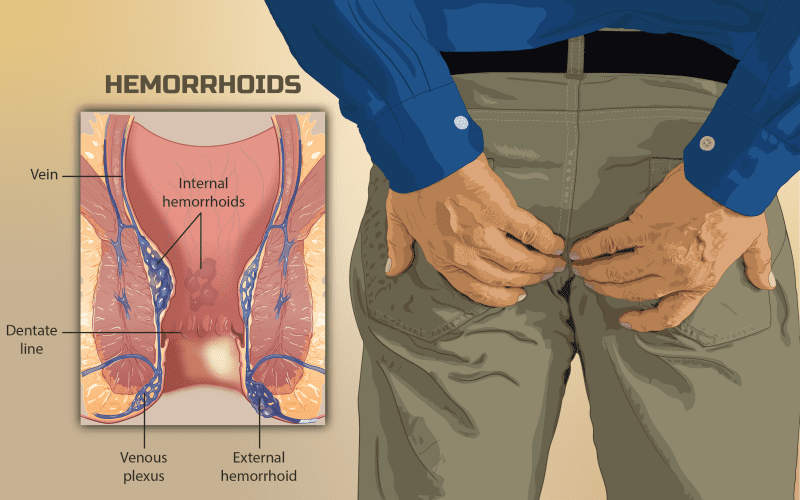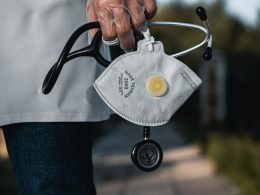Hemorrhoids (Piles)
Hemorrhoids, also known as piles, are a common medical condition characterized by swollen veins in the anus and lower rectum, akin to varicose veins. In this comprehensive guide, we explore the various types of hemorrhoids, symptoms, available treatments, and proactive measures to prevent their occurrence.
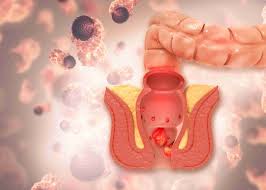
Types of Hemorrhoids
Internal Hemorrhoids
Internal hemorrhoids are situated inside the rectum, typically unnoticed and causing minimal discomfort. While they rarely cause pain, straining during bowel movements may result in painless bleeding. In some cases, internal hemorrhoids can prolapse, pushing through the anal opening and causing pain and irritation.
External Hemorrhoids
These develop under the skin around the anus, leading to symptoms such as itching, discomfort, swelling, and occasional bleeding. Unlike internal hemorrhoids, external ones are more visible and can be felt.
Thrombosed Hemorrhoids
A thrombosed hemorrhoid occurs when a blood clot forms in an external hemorrhoid, resulting in severe pain, swelling, and the presence of a hard, discolored lump near the anus.
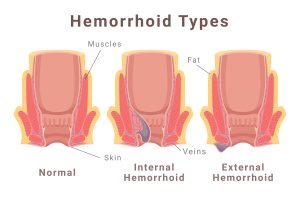
Recognizing Symptoms
- Internal Hemorrhoids: Painless bleeding during bowel movements, often evident as small amounts of bright red blood on toilet tissue or in the toilet.
- External Hemorrhoids: Itching, discomfort, swelling around the anus, and occasional bleeding.
- Thrombosed Hemorrhoids: Intense pain, inflammation, and a noticeable lump near the anus.
Seeking Medical Attention
If symptoms persist after a week of home care or if bleeding during bowel movements continues, it is crucial to consult a healthcare provider. Importantly, rectal bleeding should not be assumed to be solely due to hemorrhoids, particularly if accompanied by changes in bowel habits or alterations in stool color or consistency.
Emergency Alert: Seek immediate medical attention if there is a significant amount of rectal bleeding, along with symptoms like lightheadedness, dizziness, or faintness.
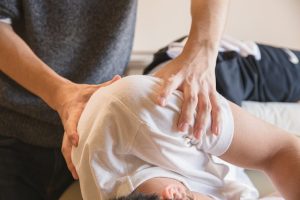
Causes and Risk Factors
Hemorrhoids develop as a result of increased pressure in the lower rectum, often associated with:
- Straining during bowel movements.
- Prolonged sitting, especially on the toilet.
- Chronic diarrhea or constipation.
- Obesity.
- Pregnancy.
- Anal intercourse.
- Low-fiber diet.
- Regularly lifting heavy items.
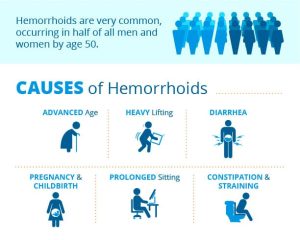
Complications
While complications related to hemorrhoids are rare, they may include:
- Anemia: Ongoing blood loss from hemorrhoids can lead to anemia, characterized by insufficient healthy red blood cells to carry oxygen to the body’s cells.
- Strangulated Hemorrhoid: Occurs when the blood supply to an internal hemorrhoid is cut off, causing extreme pain.
- Blood Clot (Thrombosed Hemorrhoid): While not dangerous, it can be extremely painful and may require drainage.
Prevention Strategies
Diet and Lifestyle Modifications
- High-fiber Foods: Incorporate more fruits, vegetables, and whole grains into your diet to soften stools and prevent straining during bowel movements.
- Adequate Hydration: Drink 6 to 8 glasses of water daily to maintain soft stools, with alcohol avoidance potentially offering additional benefits.
- Fiber Supplements: Consider nonprescription options like psyllium or methylcellulose to reduce symptoms and bleeding. It is essential to ensure sufficient fluid intake to avoid constipation.
Healthy Habits
- Avoid Straining: Refrain from straining and holding your breath during bowel movements to minimize pressure on the veins in the lower rectum.
- Regular Exercise: Stay physically active to prevent constipation and reduce pressure on veins. Additionally, exercise can aid in weight management, potentially alleviating or preventing hemorrhoids.
- Avoid Prolonged Sitting: Extended periods of sitting, particularly on the toilet, can increase pressure on the veins in the anus.

Conclusion
In conclusion, understanding and effectively managing hemorrhoids involve a multifaceted approach that encompasses recognizing symptoms, seeking timely medical attention, and adopting preventive measures. Hemorrhoids, characterized by swollen veins in the anus and lower rectum, can present as internal, external, or thrombosed, each with distinct symptoms.
Recognizing the signs of hemorrhoids is pivotal for early intervention. Internal hemorrhoids may manifest as painless bleeding, while external ones can cause itching, discomfort, and occasional bleeding. Thrombosed hemorrhoids, marked by blood clot formation, lead to severe pain and inflammation.
Timely medical attention is essential if home care fails to alleviate symptoms or if bleeding persists. It’s imperative not to assume that rectal bleeding is solely due to hemorrhoids, especially when accompanied by changes in bowel habits or alterations in stool characteristics. Immediate medical attention is warranted for significant rectal bleeding with associated symptoms like lightheadedness, dizziness, or faintness.



